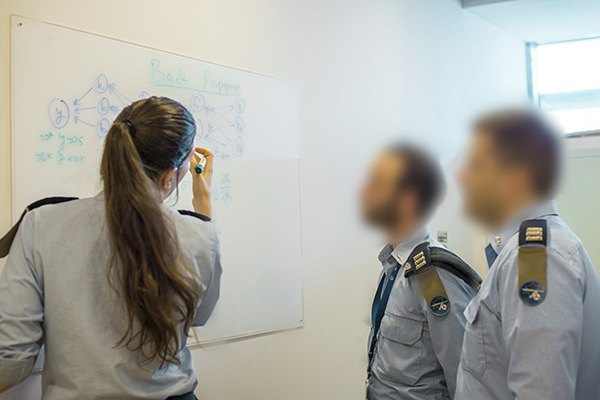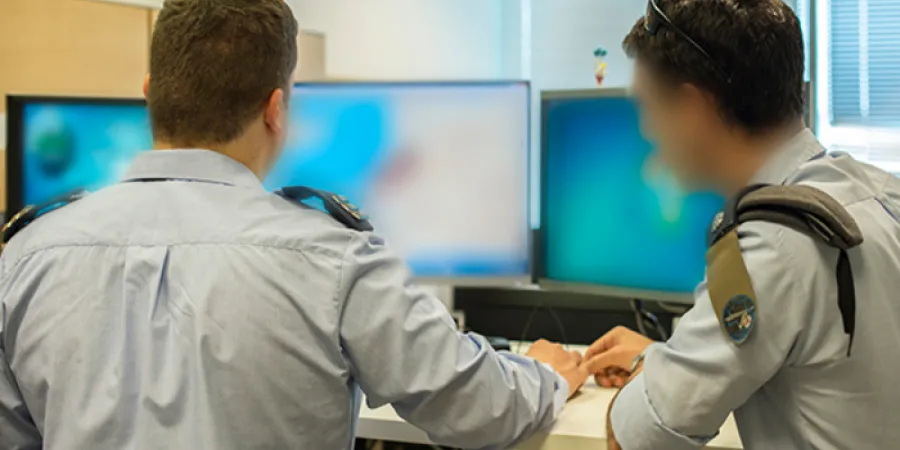Meet the Unit that Brings the Information Revolution to the IAF
The Kramim Department works alongside units which utilize artificial intelligence for various missions, and the collaborative work creates groundbreaking initiatives which place the Israeli air force at the technological forefront
IsraelDefense
| 20/05/2019
The Kramim (Hebrew for "Vineyards") Department of the IAF's Cyber & Computing Unit deals with intelligence collection, research and showcasing of operational conclusions on a daily basis, all meant to improve the air force by utilizing artificial intelligence.
"A main part of artificial intelligence research is making the most of the available knowledge through various resources," Maj. Zahi, Commander of the Kramim Department said in an interview with the IAF website. "That means we produce data from several knowledge systems, and from this new wealth of information we are able to reach operational conclusions. For example, the systems of a fighter jet returning from a sortie are full of digital data – we can then combine this data with the data from control systems, intelligence systems and the likes. Knowledge is power, and the more information we have, the more we can improve our wartime capabilities."
As part of the information revolution, an electronic data pool was established in the IAF where data from numerous sources in the force – including air defense systems, RPAVs (Remotely Piloted Aerial Vehicles) and more – is stored. The data is transferred independently and acts as an archive for the force's service members. "In the past, people would sit down with their notepads and write – now, computers do it for us. We have the ability to establish past, current and future overviews of a given area in the battlefield," said Maj. Zahi. "This is a major trend. High-tech and aerospace industries all around the world working in these fields."
The Kramim Department works alongside units which utilize AI for various missions. The collaborative work creates groundbreaking initiatives which place the Israeli air force at the technological forefront. "We work with service members from the IAF Operational HQ, including personnel from decryption units and munitions departments," elaborated Capt. A., Head of the Kramim Department's Operative Data Science team. "Everyone wants artificial intelligence in their systems nowadays, but our resources are limited. Collaborative work requires us to talk to the units we work with in order to configure our technology according to the missions at hand. People understand that not upgrading your systems is equal to regression," she added.

The department's artificial intelligence capabilities stand behind a wide variety of the force's enterprises. "The 'Transparent Maintenance' initiative utilizes AI which notifies the force's technicians about potential future malfunctions so that they can replace them before the malfunction occurs. This includes aircraft parts, engines, and even specific screws," said Capt. A. "We also utilized AI in aerial reconnaissance. RPAV operators usually need to pilot their aircraft over an area and wait for something to happen. Thanks to our technology, we are able to provide them with AI to do the overseeing for them."
Whenever technology stands against human capability there develops a certain kind of tension, where suddenly the concept of a "technological takeover" sounds not only scary, but also possible. Now, the IAF's service members have to face the question – where does the line between human intelligence and artificial intelligence cross?
"I'll begin with an example from the field of medicine," said Maj. Z. "There's a famous story about a family doctor who took in a patient with several symptoms. In the past, each doctor would analyze the symptoms by himself and come up with a prognosis, but in cases where the prognosis was not certain, additional tests were needed, then costing the patient valuable time. Then, the same doctor would input the symptoms into an AI-based system, which would provide the doctor with several potential prognoses. The doctor saw diagnoses he didn't even think about. The system did not make the decision for him, but it was based on both old and new information while also making suggestions. This kind of thing now happens in the IAF as well."
The IAF's AI systems are termed "decision supporters." With safety and human lives at hand, computerized systems cannot be trusted by themselves. "We will never let a machine operate without supervision – someone has to examine and verify the data over time," continued Maj. Z. "It's important to remember that technology isn't here to replace man-made decisions. It is here to support human decision-making and present the entirety of the available data in an organized, coherent manner. This technology signifies a change in the world, with the computer revolution leading to insights never reached before by the human mind. There are things that would take humans years to analyze while machines would take mere hours."
"Humans often work according to hunches, for better and for worse. Sometimes we do things that are the opposite of what we know to be right because we are driven by emotion. We want to believe we're better than machines, but that's not always true," said Maj. Z. "Also, we sometimes become enslaved to technology and lose our human nature. However, at the same time, machines provide us with accurate, objective results."
First published by Yael Fuchs on the IAF website
Photography: Alexandra Aksyutich
The Kramim Department works alongside units which utilize artificial intelligence for various missions, and the collaborative work creates groundbreaking initiatives which place the Israeli air force at the technological forefront
The Kramim (Hebrew for "Vineyards") Department of the IAF's Cyber & Computing Unit deals with intelligence collection, research and showcasing of operational conclusions on a daily basis, all meant to improve the air force by utilizing artificial intelligence.
"A main part of artificial intelligence research is making the most of the available knowledge through various resources," Maj. Zahi, Commander of the Kramim Department said in an interview with the IAF website. "That means we produce data from several knowledge systems, and from this new wealth of information we are able to reach operational conclusions. For example, the systems of a fighter jet returning from a sortie are full of digital data – we can then combine this data with the data from control systems, intelligence systems and the likes. Knowledge is power, and the more information we have, the more we can improve our wartime capabilities."
As part of the information revolution, an electronic data pool was established in the IAF where data from numerous sources in the force – including air defense systems, RPAVs (Remotely Piloted Aerial Vehicles) and more – is stored. The data is transferred independently and acts as an archive for the force's service members. "In the past, people would sit down with their notepads and write – now, computers do it for us. We have the ability to establish past, current and future overviews of a given area in the battlefield," said Maj. Zahi. "This is a major trend. High-tech and aerospace industries all around the world working in these fields."
The Kramim Department works alongside units which utilize AI for various missions. The collaborative work creates groundbreaking initiatives which place the Israeli air force at the technological forefront. "We work with service members from the IAF Operational HQ, including personnel from decryption units and munitions departments," elaborated Capt. A., Head of the Kramim Department's Operative Data Science team. "Everyone wants artificial intelligence in their systems nowadays, but our resources are limited. Collaborative work requires us to talk to the units we work with in order to configure our technology according to the missions at hand. People understand that not upgrading your systems is equal to regression," she added.

The department's artificial intelligence capabilities stand behind a wide variety of the force's enterprises. "The 'Transparent Maintenance' initiative utilizes AI which notifies the force's technicians about potential future malfunctions so that they can replace them before the malfunction occurs. This includes aircraft parts, engines, and even specific screws," said Capt. A. "We also utilized AI in aerial reconnaissance. RPAV operators usually need to pilot their aircraft over an area and wait for something to happen. Thanks to our technology, we are able to provide them with AI to do the overseeing for them."
Whenever technology stands against human capability there develops a certain kind of tension, where suddenly the concept of a "technological takeover" sounds not only scary, but also possible. Now, the IAF's service members have to face the question – where does the line between human intelligence and artificial intelligence cross?
"I'll begin with an example from the field of medicine," said Maj. Z. "There's a famous story about a family doctor who took in a patient with several symptoms. In the past, each doctor would analyze the symptoms by himself and come up with a prognosis, but in cases where the prognosis was not certain, additional tests were needed, then costing the patient valuable time. Then, the same doctor would input the symptoms into an AI-based system, which would provide the doctor with several potential prognoses. The doctor saw diagnoses he didn't even think about. The system did not make the decision for him, but it was based on both old and new information while also making suggestions. This kind of thing now happens in the IAF as well."
The IAF's AI systems are termed "decision supporters." With safety and human lives at hand, computerized systems cannot be trusted by themselves. "We will never let a machine operate without supervision – someone has to examine and verify the data over time," continued Maj. Z. "It's important to remember that technology isn't here to replace man-made decisions. It is here to support human decision-making and present the entirety of the available data in an organized, coherent manner. This technology signifies a change in the world, with the computer revolution leading to insights never reached before by the human mind. There are things that would take humans years to analyze while machines would take mere hours."
"Humans often work according to hunches, for better and for worse. Sometimes we do things that are the opposite of what we know to be right because we are driven by emotion. We want to believe we're better than machines, but that's not always true," said Maj. Z. "Also, we sometimes become enslaved to technology and lose our human nature. However, at the same time, machines provide us with accurate, objective results."
First published by Yael Fuchs on the IAF website
Photography: Alexandra Aksyutich



